I was so excited to make this Anti-Itch Soap that as soon as my husband walked in the door I declared, “I made Poison Ivy Soap!” He looked at me oddly and said, “I hope you didn’t put poison ivy in soap, Kelly.” That made me laugh. I guess he doesn’t know what I’m going to do next, sometimes.
This Soap is made with Jewelweed to stop the spread of poison ivy on and under the skin.
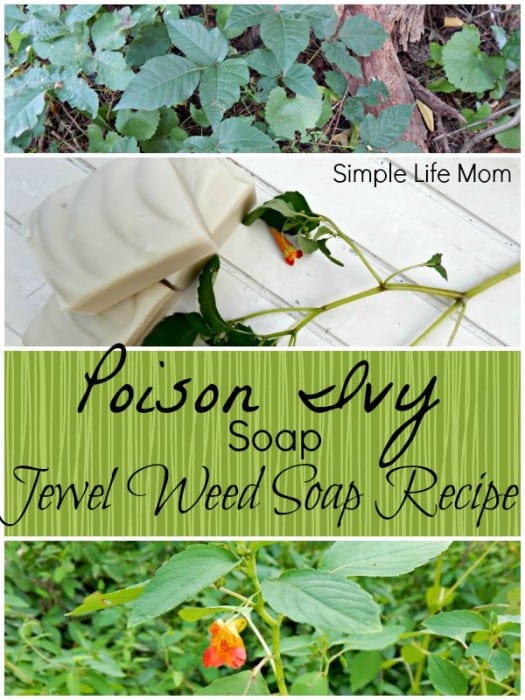
Jewelweed
Jewelweed, a.k.a. Touch Me Not, Impatient, Snap Weed, and whatever your grandma calls it, has a number of nicknames because it’s common in most wooded areas of North America and Europe.
This is great, because it means you quite possibly have some growing near your home.
Jewelweed likes to grow in shaded areas with access to plenty of water. This is because its root system is very shallow. If you try to break off a stem you are likely to pull up the entire plant.
My kids learned quickly that you can eat the seed pods. They are called Snap Weed or Touch Me Nots, because when the pods are ready they will snap open at the slightest touch. These pods are fine to eat, but the rest of the plant is poisonous.
Jewelweed flowers in North Eastern America in mid-July. They almost look like little snap dragons on 3 foot high stalks or small bushes with tear drop leaves. The flowers will either be yellow (Pale Jewelweed) or orange with red spots (Spotted Jewelweed).
Killing the Itch
Jewelweed has a lot of liquid inside of the stem and leaves that neutralizes Urushial (the chemical that makes you itch in poison ivy, sumac, and poison oak). You can get to it by simply breaking and crushing the stem in your fist.
This liquid can be used right away on a burn, rash, or itch. If you’ve been hiking or cutting grass with Poison Ivy, take a second and crush Jewelweed and rub it on that skin.
The second thing you should do is wash the oils off – just in case you missed any, or it’s not Jewelweed season, or you don’t have any growing in your back yard. Just like you’d get grease off a greasy dish, you want to work to make sure the poison ivy oil is off of your skin. If you do this right after you are exposed, then you probably won’t break out at all!! Awesome, right?
Using Jewelweed Soap
Jewelweed soap is a soap made with Jewelweed infused water and oils. It is packed with Jewelweed! I also recommend using camphor essential oil in your soap. This will help to calm any irritated skin and soothe itching if you are already starting to break out.
Just as I said above, the key is using it immediately after exposure and scrubbing down to make sure you don’t give the poison ivy oils time to penetrate to deeper layers of skin.
How To Make Poison Ivy Soap with Jewelweed
1) Collect Jewelweed – If it’s growing prolifically in your area, just pull some of it up. Don’t forget to leave enough so that the patch will continue to produce for you each year.
2) Infuse Water – Place the water from the soap recipe in a large pot (a little more than enough because some will evaporate). Fold up and smash some Jewelweed. You can cut it with a knife, or just bend and smash with your hands. Put the Jewelweed in the water and heat on low until the water is a dark golden color. Strain water through a fine sieve and discard Jewelweed.
3) Infuse Oils – Weigh and combine your coconut and olive oils into a pot and add crushed Jewelweed. Simmer on very low for an hour or until the oils are a bright green (Yes, bright green, and it’s beautiful! **Spoiler – It doesn’t last in the soap). Use tongs to pull out the jewelweed from the oils, strain through a fine sieve if needed. Discard Jewelweed.
You’re ready to go! Make cold process soap as you normally would.
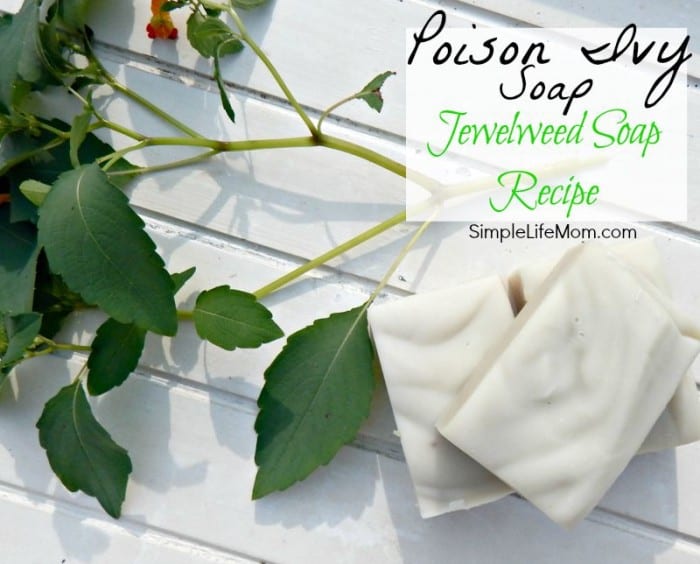
Find it in my Shop!
Poison Ivy Soap Recipe
This recipe makes 2.5 pounds and 5% superfat content.
Ingredients:
- 14 ounces tallow or lard
- 5 ounces coconut oil
- 7 ounces olive oil
- 3.6 ounces lye
- 10 ounces jewelweed infused water
- 0.75 ounces camphor essential oil
- Fresh jewelweed. A few stems; enough to add to oils and water.
Instructions:
- Combine Tallow, Coconut Oil, and Olive Oil. Heat over medium low heat to melt oils. Add a few handfuls of fresh jewelweed that is crushed with your hands and allow to cool to 90 degrees Fahrenheit.
- Make jewelweed tea with the water and allow to cool.
- With gloves, goggles, and mask, weigh lye in a plastic zip close bag. Take lye and jewelweed water outside. Add lye to the water and stir until dissolved. The water will discolor from the herbs. This is normal and will not effect the soap. Allow to cool to 90 degrees Fahrenheit.
- Add lye water to oils and mix with a stick or hand mixer until light trace.
- Add essential oils and blend.
- Pour into a prepared mold and insulate for 24 hours before removing and cutting.
- Allow to cure for 3-4 weeks.
Below is the recipe in printable format. It also has links and little more information if needed. Let me know if you have any questions.
Poison Ivy Soap with Jewelweed
Equipment
Ingredients
- 14 ounces Tallow or Lard
- 5 ounces Coconut Oil
- 7 ounces Olive Oil
- 3.6 ounces Lye
- 10 ounces water
- 0.75 ounces Camphor Essential Oil
- Enough fresh jewelweed to infuse the oils and water.
Instructions
- Combine Tallow, Coconut Oil, and Olive Oil. Heat over medium low heat to melt oils. Add a few handfuls of fresh jewelweed that is crushed with your hands and allow to cool to 90 degrees Fahrenheit.14 ounces Tallow or Lard, 5 ounces Coconut Oil, 7 ounces Olive Oil, Enough fresh jewelweed to infuse the oils and water.
- Make jewelweed tea with the water and allow to cool.Enough fresh jewelweed to infuse the oils and water.
- With gloves, goggles, and mask, weigh lye in a plastic zip close bag. Take lye and jewelweed water outside. Add lye to the water and stir until dissolved. The water will discolor from the herbs. This is normal and will not effect the soap. Allow to cool to 90 degrees Fahrenheit.3.6 ounces Lye, 10 ounces water
- Add lye water to oils and mix with a stick or hand mixer until light trace.
- Add essential oils and blend.0.75 ounces Camphor Essential Oil
- Pour into a prepared mold and insulate for 24 hours before removing and cutting. Allow to cure for 3-4 weeks.
For More Detailed instructions on how to make cold processed soap, see: 7 Easy Steps to Homemade Lye Soap for Beginners.
Please share!


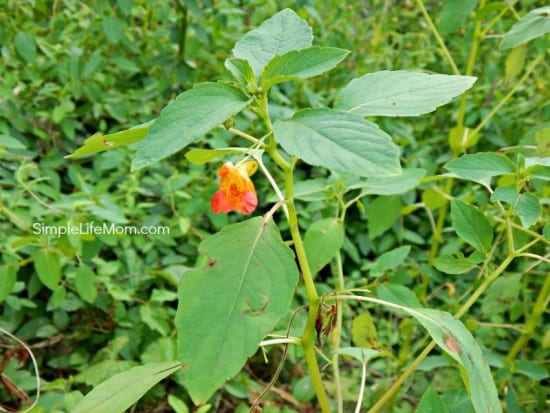
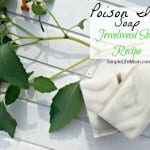
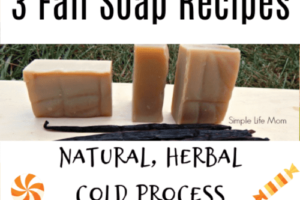

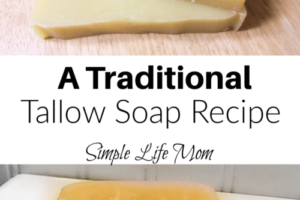

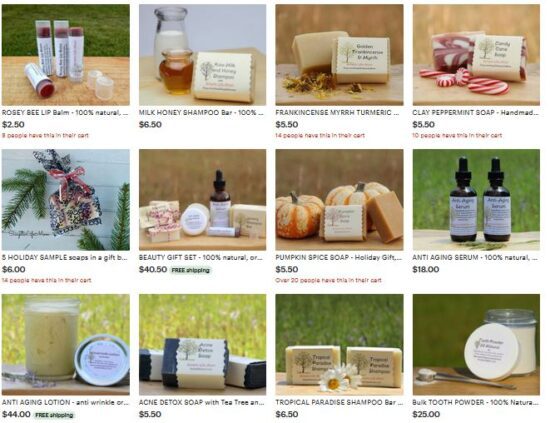
64 Comments
Leave your reply.